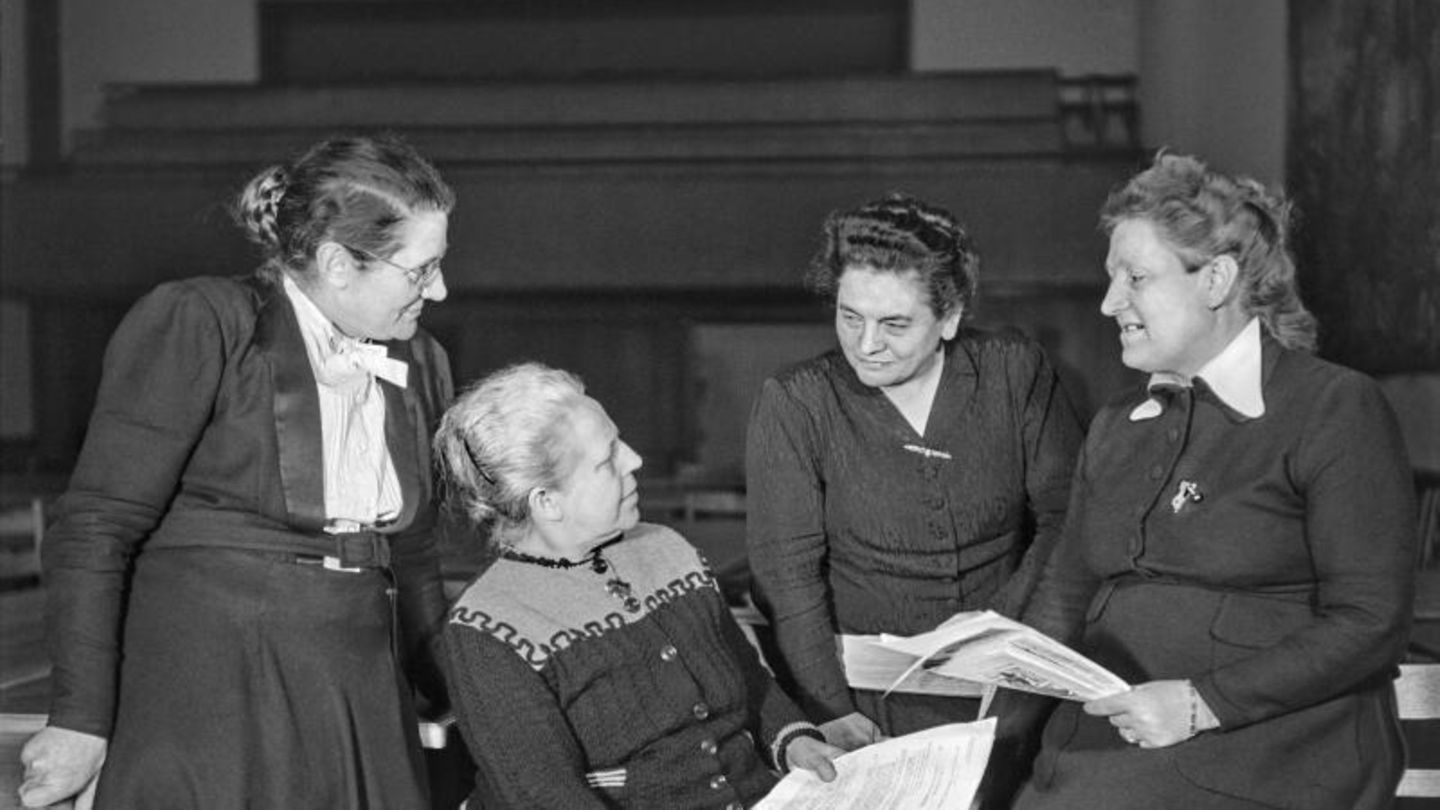The Basic Law was drafted in Bonn 75 years ago under very provisional conditions. Some things were specified by the Allies, others were fought over. Equality between men and women was particularly controversial.
The stuffed animals were discreetly draped or cleared away, but the place must have had something exotic about it: 75 years ago, on September 1, 1948, the Koenig Natural History Museum in Bonn hosted the opening ceremony of the Parliamentary Council – the body that draft the Basic Law for a new West German state. The museum was chosen simply because it was one of the few buildings to have survived the war undamaged. The venue for the actual deliberations was the Pedagogical Academy, 500 meters away. In retrospect, the innovative architecture of this building in the sober Bauhaus style can almost be considered a symbol of the Basic Law.

© serienlicht / Imago Images
Very close
Are you interested in politics? – and read the most important information of the week, selected for you by our Berlin political experts!
“The population actually took no part in the creation of the Basic Law”
Gerhart Baum (FDP), who is now 90 years old, was just under 16 at the time and attended the Tegernsee Gymnasium in Bavaria. “We weren’t aware that something completely new was being created in Bonn,” recalls the later Federal Minister of the Interior in an interview with the German Press Agency in his apartment in Cologne. “The population actually took no part in the creation of the Basic Law.” One had other things to do, one was busy with daily survival.
“But there was also the general environment, which wasn’t that pro-democracy at all,” says Baum. “We had teachers who hadn’t even realized that we were now living in a democracy. At the time, I wanted to hold a celebration at school in memory of the resistance fighters of July 20th – but the teaching staff forbade us to do that. The were ‘traitors to the fatherland’.”
The lessons of the Weimar Republic
The Western Allies had instructed the Parliamentary Council that it should draw up a democratic constitution with a strong federal structure, because as a lesson learned from the end of the Weimar Republic, power should be distributed as widely as possible between the federal and state governments. The representatives of the existing state parliaments, on the other hand, had prevailed on the occupying powers that the Parliamentary Council should not formulate a constitution, but only a provisional “Basic Law”: In their eyes, the West German state that was still to be founded should only be a short-lived provisional solution until reunification with the eastern zone be.
The 65 voting members of the Parliamentary Council, who had been delegated from the state parliaments, belonged to different parties and some were persecuted by the Nazi regime, some were followers. There were hardly any real victims of the Nazis. “The crucial thing is that we were able to reach an agreement across all party lines and pre-existing influences of the Weimar period,” emphasizes Baum. “The political camps came together.”
The Basic Law: a constitution based on the principle of human dignity
This spirit is also reflected in the intimate images of the Düsseldorf photographer Erna Wagner-Hehmke, who accompanied the consultations. Her atmospheric photographs – which are currently on display in the House of History in Bonn – often show the council members in small, informal groups, standing in the aisle smoking and discussing, or sitting under the trees with a coffee.
If you wanted to single out one of those involved, it would probably be law professor Carlo Schmid from the SPD. However, the friendly scholar worked more in the background – the power-conscious later Chancellor Konrad Adenauer (CDU) became President of the Council.
“The special thing about the Basic Law is that it was the first German constitution to be based on the principle of human dignity,” says Baum, who still works as a lawyer today. “In contrast to the Weimar Constitution, the Basic Law binds the entire state authority to fundamental rights.” Some of the most important basic rights also have an eternity character, which means that their restriction is not possible even through a parliamentary resolution. “It took a deep moral crash through Nazi barbarism to get there.”
However, the details were hotly debated. The only four female members of the council had to fight for the sentence “men and women are equal” for a long time. The “fathers of the Basic Law” originally wanted to prevent such a clear formulation. Theodor Heuss (FDP), who later became the first Federal President, explained that it would be enough if women were given the same civil rights. In the family, however, the man should continue to have the last word in all matters.
The “mothers” of the Basic Law
The four “mothers” of the Basic Law, led by the resolute SPD politician Elisabeth Selbert (1896-1986), were not satisfied with that. They demanded that all areas of law, including family law, should be reformed according to the principle of equal rights. On Selbert’s initiative, the council was overwhelmed with letters from angry women. Selbert even turned directly to the wives of all CDU council members so that they should also put pressure on them. With success: the resistance of the men collapsed.
The Basic Law was signed in Bonn on May 23, 1949 – and adopted in 1990 when West and East Germany were reunited. “At the time, I was absolutely against drafting a new constitution,” says Gerhart Baum. In the end, the Basic Law proved its worth. “We couldn’t wish for a better constitution.”
Source: Stern
I have been working in the news industry for over 6 years, first as a reporter and now as an editor. I have covered politics extensively, and my work has appeared in major newspapers and online news outlets around the world. In addition to my writing, I also contribute regularly to 24 Hours World.




